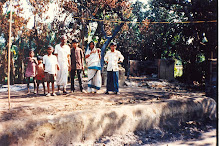Election 2008: Defenders of the minority vote
Naeem Mohaiemen
http://thedailystar.net/story.php?nid=67244
AT a seminar last week discussing the newly formed National Human Rights Commission, it was pointedly asked why it had no minority members. The chairman had no reply for us, but the question kept percolating in the room.
In another air-con room a week later, the Awami League unveiled its election manifesto. Section 18.1 pledges to improve the condition of minorities, adivasis, indigenous people, and dalits, by removing discriminatory laws, forming land commission to protect their land, creating job opportunities, etc. Section 18.2 talks about implementation of the CHT Peace Accord.
Those who recall the abrupt volte face of the AL-Khelafot Andolon alliance of December 2006, or who are distressed at the alliance presence of JP which inserted "Islam as state religion" into the constitution, will remain cautious. But while guarded, we may still hope for an incremental shift in political parties' commitment to minority rights.
Historically, minority communities have been perceived to vote for the AL (if only because the other parties are increasingly hard-line on religion). This was manifested in 2001, when Hindu voters were prevented from voting in many areas. After the BNP-Jamaat victory, BNP-allied local gangs attacked Hindu villages. According to press reports at the time, the southwestern and southern part of Bangladesh (popularly known as the 'Hindu belt') was worst affected.
Meghna Guhathakurta, in a forthcoming essay (Journal of Social Studies No. 121 January-March 2009), describes a visit to Bhola, one of the worst affected districts: "Among the atrocities committed were charging into households, attacking men, women and children with sharp knives and weapons, in certain cases threatening with guns, terrorizing women and children by beating and chasing them and in certain cases raping and attempting rape. Looting of Hindu households and sometimes Muslim households which sheltered Hindus took place throughout the night and in waves since most householders had fled in terror and their houses were left unguarded."
According to research done by a rights NGO, based on the National Democratic Institute (NDI) data-set, the 1991 and 2001 Bangladesh election results could have been different given the razor-thin margins by which many seats were won, and the huge number of minority voters that were prevented from voting in those very seats. Out of 300 constituencies for parliament seats, there are 71 where minority voters are significant (ranging from 11% to 61%) and 50 where they are visible (5-10%). According to the 2001 Population Census, the Hindu population was 11,379,000 -- 9.2 per cent of the total.
These statistics do not count other religious minorities, nor ethnic minorities. If we look at the intersection between religious and ethnic minority in Jumma people of Chittagong Hill Tracts, we find these were areas with lowest voter turnout. According to analysis of NDI data by Rahman & Ahamed (Daily Star, Dec 12), there were 850 centres where voter turnout in 2001 was less than half of total registered voters. Of these, 87 centres were in Cox's Bazaar, 49 in Bandarban, 67 in Rangamati, and 36 in Khagrachari. In addition, around 87 centres with less than 50 per cent turnout were in Cox's Bazaar-3. There were 35 polling centres where voter turnout was as low as or lower than 10 %. Of these, 18 were in Rangamati, 8 in Khagrachari, 5
in Cox's Bazaar-3, and 2 in Bandarban.
Looking at specific constituencies in 2001, Rahman & Ahamed (Daily Star, Dec 13) zero in on Bagerhat-4 where 12% voters are religious minority, and Khulna-5 where 40% of voters are religious minority. Looking at the NDI data, there is clear evidence of violence which resulted in Hindu-majority polling centres being closed, Hindu voters staying away from polls, as well as manipulation of vote counting to exclude the Hindu vote. In both constituencies, a Jamaat-e-Islami candidate was declared the winner.
As a result of the tremendous pre- and post-election violence directed at minorities in 2001, this has become an area of specific interest for international election observers in 2008. Local human rights defenders are doing outreach to make sure minority voters do not get intimidated. But so much more is needed, including a public commitment to this from the Election Commission and other administration.
In India's West Bengal, Trinamool and Left Front compete with each other to woo the minority vote (in their case, the Muslims). Of course this is practical politics -- West Bengal has a 27% Muslim population, and there is no law like Bangladesh's Vested Property Act that creates downward pressure on their numbers (in fact the Muslim voter numbers have gone up with each elections). In Bangladesh, as the Hindu
population is going down due to VPA, politicians think the minority vote does not have to be respected, nor do many worry about ensuring that these voters can enter polling booths safely.
A call to protect minority rights must come from the majority. I place my hope on ordinary citizens, the silent majority, the secular Muslim. We can and must defend Bangladesh's secular core, starting with the minority vote.
Naeem Mohaiemen (naeem.mohaiemen@gmail.com) has written about minorities for Ain o Salish Kendra and Drishtipat.
Subscribe to:
Post Comments (Atom)

No comments:
Post a Comment